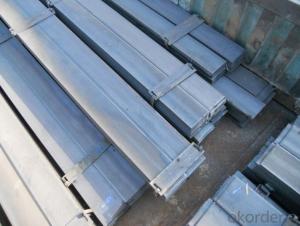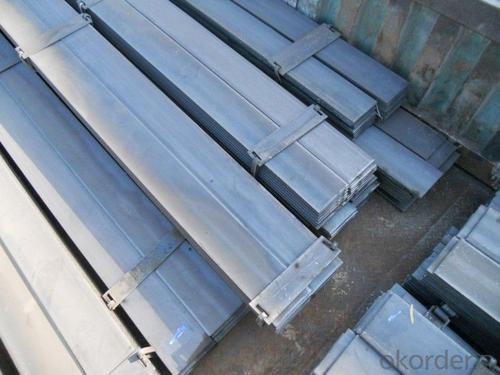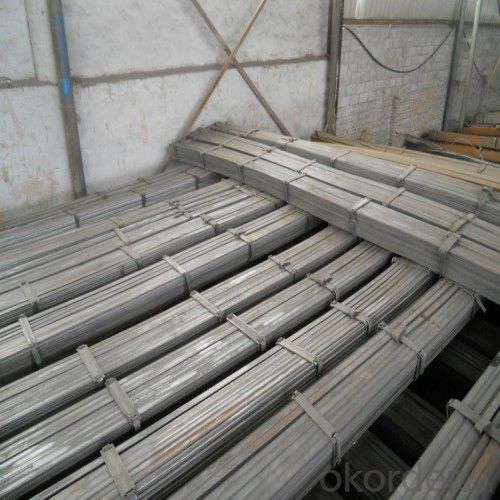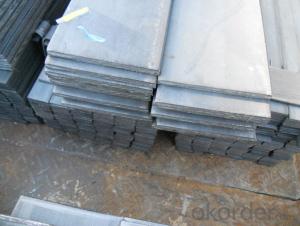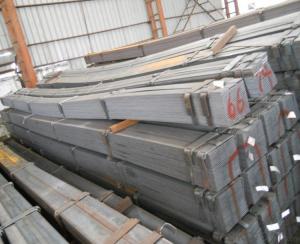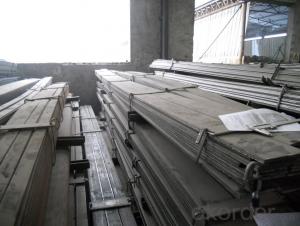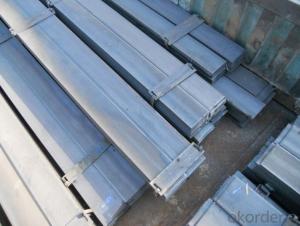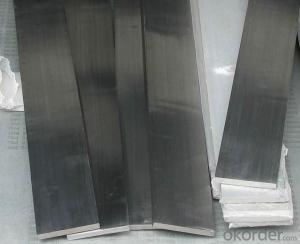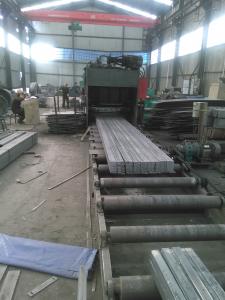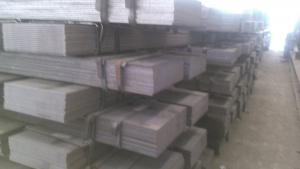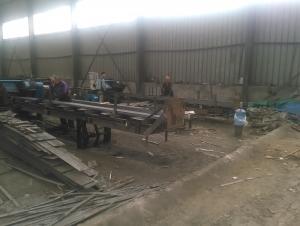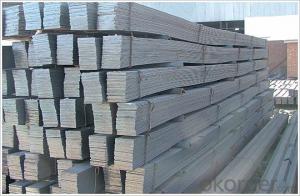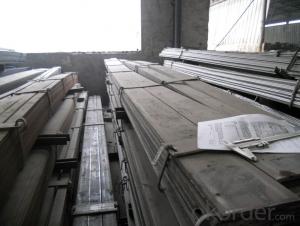Q235 steel flat bars with high quality and good price
- Loading Port:
- Tianjin
- Payment Terms:
- TT OR LC
- Min Order Qty:
- 25 m.t.
- Supply Capability:
- 100000 m.t./month
OKorder Service Pledge
OKorder Financial Service
You Might Also Like
Mild Steel Flat Bar Details:
| Minimum Order Quantity: | 25 m.t. | Unit: | m.t. | Loading Port: | China Main Port |
| Supply Ability: | 80000-100000MTS/YEAR m.t./month | Payment Terms: | TT or LC |
Product Description:
Specification of Mild Steel Flat Bar
Commodity: Mild Steel Flat Bar
Standard: GB;JIS
Material: Q195-235;SS400
Brand name: FLATSPACE
Origin place: China
Thickness: 3mm-30mm
Width:20mm-200mm
Length: Max 12m
Certification: SGS/BV
Chemical composition of Q235
Alloy No | Grade | Element(%) | ||||
C
| Mn
| S
| P
| Si
| ||
Q235
|
B
|
0.12—0.20 |
0.3—0.7 |
≤0.045 |
≤0.045
|
≤0.3
|
Physical properties of Q235
Alloy No | Grade | Yielding strength point(Mpa) | Tensile strength (Mpa) | Elongation after fracture(%) | ||||||
Thickness (mm) | Thickness (mm) | |||||||||
≤16 | >16--40 | >40--60 | >60--100 | ≤16 | >16--40 | >40--60 | >60--100 | |||
≥ | ≥ | |||||||||
Q235 |
B |
235 |
225 |
215 |
205 |
375--500 |
26 |
25 |
24 |
23 |
Usage/Applications of Mild Steel Flat Bar
Widely used for construction, Machinery manufacturing, Iron tower steel structure, Shipbuilding; Steel grating, Staircase, Bridge, Viaduct, Railway spare parts, Boilers making etc.
Packaging & Delivery of Mild Steel Flat Bar
Packaging Details: The Mild Steel Flat Bars are packed in bundles and loaded in 20 feet/40 feet container, or shipped by bulk cargo ,also we can do as customer's requirements.
Delivery Details:30~45 days upon the receipt of buyer payment by T.T. or L/C.
Production Flow of Mild Steel Flat Bar
The Mild steel flat bar is made through three processes:
1.Feeding the material: Feeding the row material (the steel plate) to Slitting Line.
2.Slitting:The steel plate would be slitted into expected width by lengthways cutter.
3. Leveled and cutting: The plat bar would be ground into level by the grinder and then cut into required length.
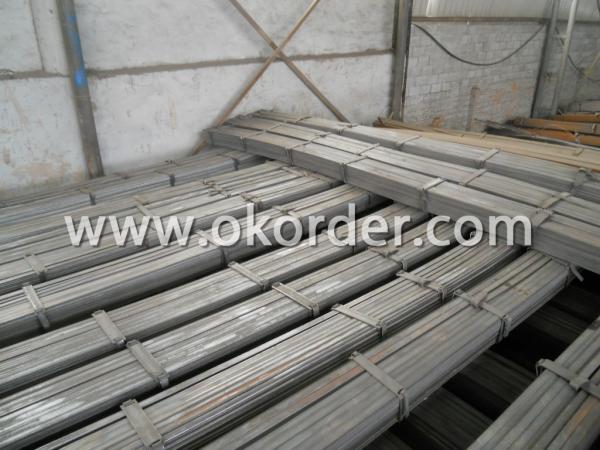
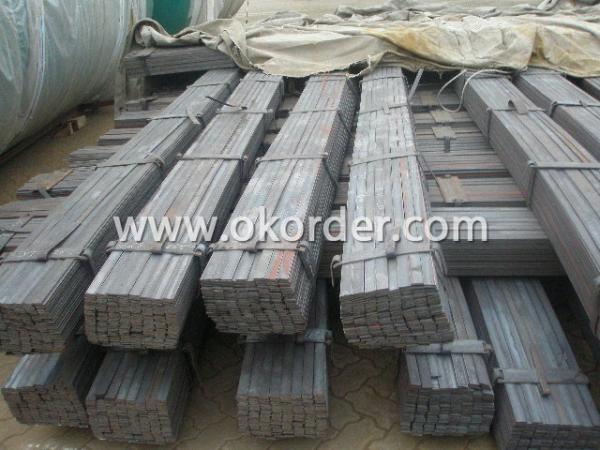

FLATSPACE is specialized in production and sales of slit flat bars. We offered the individuation processing service of slitting and crosscut. Our flat bar the width form 10mm to 1800mm, and thichness from 2.5mm to 25mm.
View Manufacturer's Shop
1. Manufacturer Overview | |
|---|---|
| Location | Hebei, China |
| Year Established | 2009 |
| Annual Output Value | Above US$ 150 Million |
| Main Markets | Southeast Aisa, Middle east, Africa |
| Company Certifications | |
2. Manufacturer Certificates | |
|---|---|
| a) Certification Name | |
| Range | |
| Reference | |
| Validity Period | |
3. Manufacturer Capability | |
|---|---|
| a)Trade Capacity | |
| Nearest Port | Tianjin |
| Export Percentage | 70%-80% |
| No.of Employees in Trade Department | 10-15 people |
| Language Spoken: | English; Chinese |
| b)Factory Information | |
| Factory Size: | Above 20,000 square meters |
| No. of Production Lines | 7 |
| Contract Manufacturing | OEM Service Offered; |
| Product Price Range | Average |
- Q: Can steel flat bars be used for making machinery frames?
- Machinery frames can indeed be constructed using steel flat bars. The use of steel flat bars is widespread across various industries, particularly in machinery manufacturing, owing to their remarkable strength, durability, and versatility. The flat shape of these bars facilitates easy fabrication and welding, enabling the creation of frames in a wide range of sizes and shapes. By employing steel flat bars, a stable and inflexible structure can be achieved, guaranteeing the stability and long life of machinery frames. Furthermore, steel is renowned for its ability to bear heavy loads and vibrations, making it an ideal choice for withstanding the challenges that machinery frames may face. In conclusion, steel flat bars are a dependable option when it comes to constructing machinery frames, as they provide the necessary strength and stability for the smooth operation of the machinery.
- Q: How do you determine the strength of a steel flat bar?
- The strength of a steel flat bar can be determined through several methods. One of the most common methods is through tensile testing, which involves applying a pulling force on a specimen until it fractures. During this test, the load and deformation are measured, and the stress and strain values are calculated. From these calculations, various mechanical properties such as yield strength, ultimate tensile strength, and elongation can be determined. Another method to determine the strength of a steel flat bar is through hardness testing. Hardness measures the material's resistance to indentation or scratching and is often correlated with its strength. The most commonly used hardness tests for steel include Brinell, Rockwell, and Vickers hardness tests. Additionally, one can determine the strength of a steel flat bar by considering its chemical composition. Steel is an alloy composed primarily of iron and carbon, with other elements such as manganese, chromium, and nickel added to enhance specific properties. The composition and heat treatment of the steel can significantly affect its strength. It is important to note that the bending properties, such as flexural strength, of a steel flat bar can also be analyzed through tests like the three-point bending test or the four-point bending test. These tests determine the maximum load a specimen can withstand before it breaks or yields in bending. In conclusion, the strength of a steel flat bar can be determined through tensile testing, hardness testing, considering its chemical composition, and analyzing its bending properties. These methods provide valuable information about the steel's mechanical properties, allowing engineers and manufacturers to select the appropriate steel grade for specific applications.
- Q: How do steel flat bars differ from steel round bars?
- Steel flat bars and steel round bars exhibit dissimilarities in their shape and structural characteristics. The primary dissimilarity between steel flat bars and steel round bars lies in their shape. Steel flat bars possess a rectangular form with sharp edges and a level surface on the top and bottom. Conversely, steel round bars possess a circular cross-section, resembling a rod or cylinder. Regarding structural properties, steel flat bars and steel round bars also differ. Steel flat bars are often favored for applications necessitating a robust load-bearing capacity in a horizontal direction, such as weight support or structural stability provision. The flat surface facilitates better weight distribution, thereby preventing bending or warping under substantial loads. Contrarily, steel round bars are typically employed in applications requiring strength and durability in diverse directions, encompassing both vertical and horizontal forces. The circular shape of round bars confers excellent resistance to bending and twisting, rendering them suitable for usage in construction, machinery, and automotive components. Moreover, the manufacturing process for steel flat bars and steel round bars may diverge as well. Steel flat bars are usually fabricated through hot rolling, entailing the passage of heated steel through a succession of rollers to achieve the desired shape. Steel round bars can be manufactured via both hot rolling and cold drawing processes, where the steel is either heated and passed through rollers or drawn through a die to form the circular shape. In essence, steel flat bars and steel round bars can be distinguished based on their shape, structural properties, and manufacturing processes. Gaining an understanding of these disparities is vital when selecting the appropriate steel bar for a particular application.
- Q: Can steel flat bars be used for making handrails or balustrades?
- Yes, steel flat bars can be used for making handrails or balustrades. They are strong and durable, making them suitable for providing support and safety in a variety of architectural and construction applications.
- Q: Can steel flat bars be used for manufacturing sports equipment or accessories?
- Yes, steel flat bars can be used for manufacturing sports equipment or accessories. Steel is a strong and durable material that can withstand the rigors of sports activities. Flat bars made of steel can be shaped and formed into various products such as baseball bats, golf clubs, weightlifting bars, bicycle frames, and many others. The versatility of steel allows for customization and adaptation to specific sporting needs. Additionally, steel flat bars can be easily welded, providing further flexibility in the manufacturing process. Overall, steel flat bars are a suitable material for producing sports equipment and accessories due to their strength, durability, and ability to be shaped into desired forms.
- Q: Can steel flat bars be used for making hand tools or equipment?
- Yes, steel flat bars can be used for making hand tools or equipment. Steel is a strong and durable material that is commonly used in the manufacturing of various tools and equipment. Flat bars are versatile and can be easily shaped and formed into different designs and sizes to meet the specific requirements of hand tools or equipment. Additionally, steel flat bars provide excellent strength and stability, making them suitable for applications where durability and reliability are essential. Furthermore, steel is resistant to corrosion, which ensures that the hand tools or equipment made from steel flat bars will have a longer lifespan. Overall, steel flat bars are a popular choice for making hand tools or equipment due to their strength, versatility, and durability.
- Q: How do steel flat bars contribute to the overall safety of public structures?
- Steel flat bars contribute to the overall safety of public structures in several ways. Firstly, they provide structural support and reinforcement, enhancing the strength and stability of the structure. This helps to prevent collapse or structural failure, ensuring the safety of people who occupy or pass by the building. Additionally, steel flat bars are resistant to fire, corrosion, and extreme weather conditions, making them a durable and reliable choice for public structures. Their high tensile strength also allows them to withstand heavy loads and impacts, reducing the risk of accidents or damage. Overall, steel flat bars play a crucial role in enhancing the safety and longevity of public structures.
- Q: What are the different certifications and standards for steel flat bars?
- Steel flat bars can be certified and standardized to ensure their quality and suitability for different purposes. Some well-known certifications and standards are: 1. ASTM International (previously the American Society for Testing and Materials): ASTM A108 is a standard specification for cold-finished carbon and alloy steel bars, while ASTM A36 is a standard specification for carbon structural steel, covering shapes, plates, and bars of structural quality. 2. American Iron and Steel Institute (AISI): AISI 1018 is a popular low carbon steel grade commonly used in steel flat bars. It adheres to AISI standards and is renowned for its excellent weldability and machinability. 3. Society of Automotive Engineers (SAE): SAE 4140 is a high-strength steel alloy often employed in steel flat bars. It meets the SAE J404 standard, which sets chemical composition limits for carbon and alloy steel bars. 4. European Norms (EN): EN 10025-2 is a standard specification for hot-rolled structural steel products, including steel flat bars. It outlines technical delivery conditions for non-alloy structural steels. 5. International Organization for Standardization (ISO): ISO 683-3 is a standard that defines technical delivery requirements for hot-rolled or forged steel bars, covering various grades and conditions. 6. British Standards (BS): BS EN 10025-2 is a British standard aligned with European Norms. It specifies technical delivery conditions for non-alloy structural steels, including steel flat bars. It is important to note that specific applications may require additional certifications or standards. For instance, steel flat bars used in construction must meet specific building codes or regulations set by local authorities. Industries like aerospace or automotive may also have unique certifications or standards to ensure the performance and safety of steel flat bars used in their applications.
- Q: What is the maximum thickness-to-width ratio for steel flat bars?
- The maximum thickness-to-width ratio for steel flat bars can vary depending on the specific grade and type of steel being used. However, in general, the maximum thickness-to-width ratio for steel flat bars is typically around 1:10. This means that the thickness of the bar should not exceed 10 times its width. It is important to note that this ratio may vary based on the specific application and industry standards, so it is always advisable to consult relevant engineering codes and standards to determine the maximum thickness-to-width ratio for a specific steel flat bar.
- Q: Can steel flat bars be cut to length?
- Yes, steel flat bars can be cut to length using various cutting tools such as saws or shears.
Send your message to us
Q235 steel flat bars with high quality and good price
- Loading Port:
- Tianjin
- Payment Terms:
- TT OR LC
- Min Order Qty:
- 25 m.t.
- Supply Capability:
- 100000 m.t./month
OKorder Service Pledge
OKorder Financial Service
Similar products
Hot products
Hot Searches
Related keywords
